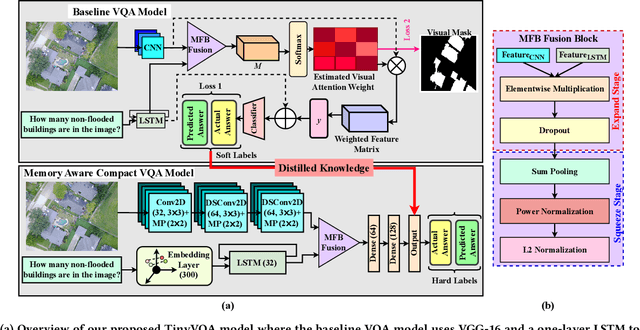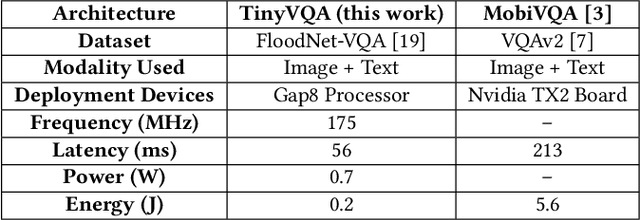Maryam Rahnemoonfar
GRIT: Graph Transformer For Internal Ice Layer Thickness Prediction
Jul 10, 2025Abstract:Gaining a deeper understanding of the thickness and variability of internal ice layers in Radar imagery is essential in monitoring the snow accumulation, better evaluating ice dynamics processes, and minimizing uncertainties in climate models. Radar sensors, capable of penetrating ice, capture detailed radargram images of internal ice layers. In this work, we introduce GRIT, graph transformer for ice layer thickness. GRIT integrates an inductive geometric graph learning framework with an attention mechanism, designed to map the relationships between shallow and deeper ice layers. Compared to baseline graph neural networks, GRIT demonstrates consistently lower prediction errors. These results highlight the attention mechanism's effectiveness in capturing temporal changes across ice layers, while the graph transformer combines the strengths of transformers for learning long-range dependencies with graph neural networks for capturing spatial patterns, enabling robust modeling of complex spatiotemporal dynamics.
ST-GRIT: Spatio-Temporal Graph Transformer For Internal Ice Layer Thickness Prediction
Jul 10, 2025Abstract:Understanding the thickness and variability of internal ice layers in radar imagery is crucial for monitoring snow accumulation, assessing ice dynamics, and reducing uncertainties in climate models. Radar sensors, capable of penetrating ice, provide detailed radargram images of these internal layers. In this work, we present ST-GRIT, a spatio-temporal graph transformer for ice layer thickness, designed to process these radargrams and capture the spatiotemporal relationships between shallow and deep ice layers. ST-GRIT leverages an inductive geometric graph learning framework to extract local spatial features as feature embeddings and employs a series of temporal and spatial attention blocks separately to model long-range dependencies effectively in both dimensions. Experimental evaluation on radargram data from the Greenland ice sheet demonstrates that ST-GRIT consistently outperforms current state-of-the-art methods and other baseline graph neural networks by achieving lower root mean-squared error. These results highlight the advantages of self-attention mechanisms on graphs over pure graph neural networks, including the ability to handle noise, avoid oversmoothing, and capture long-range dependencies. Moreover, the use of separate spatial and temporal attention blocks allows for distinct and robust learning of spatial relationships and temporal patterns, providing a more comprehensive and effective approach.
AI-ready Snow Radar Echogram Dataset (SRED) for climate change monitoring
May 01, 2025Abstract:Tracking internal layers in radar echograms with high accuracy is essential for understanding ice sheet dynamics and quantifying the impact of accelerated ice discharge in Greenland and other polar regions due to contemporary global climate warming. Deep learning algorithms have become the leading approach for automating this task, but the absence of a standardized and well-annotated echogram dataset has hindered the ability to test and compare algorithms reliably, limiting the advancement of state-of-the-art methods for the radar echogram layer tracking problem. This study introduces the first comprehensive ``deep learning ready'' radar echogram dataset derived from Snow Radar airborne data collected during the National Aeronautics and Space Administration Operation Ice Bridge (OIB) mission in 2012. The dataset contains 13,717 labeled and 57,815 weakly-labeled echograms covering diverse snow zones (dry, ablation, wet) with varying along-track resolutions. To demonstrate its utility, we evaluated the performance of five deep learning models on the dataset. Our results show that while current computer vision segmentation algorithms can identify and track snow layer pixels in echogram images, advanced end-to-end models are needed to directly extract snow depth and annual accumulation from echograms, reducing or eliminating post-processing. The dataset and accompanying benchmarking framework provide a valuable resource for advancing radar echogram layer tracking and snow accumulation estimation, advancing our understanding of polar ice sheets response to climate warming.
Multi-branch Spatio-Temporal Graph Neural Network For Efficient Ice Layer Thickness Prediction
Nov 06, 2024Abstract:Understanding spatio-temporal patterns in polar ice layers is essential for tracking changes in ice sheet balance and assessing ice dynamics. While convolutional neural networks are widely used in learning ice layer patterns from raw echogram images captured by airborne snow radar sensors, noise in the echogram images prevents researchers from getting high-quality results. Instead, we focus on geometric deep learning using graph neural networks, aiming to build a spatio-temporal graph neural network that learns from thickness information of the top ice layers and predicts for deeper layers. In this paper, we developed a novel multi-branch spatio-temporal graph neural network that used the GraphSAGE framework for spatio features learning and a temporal convolution operation to capture temporal changes, enabling different branches of the network to be more specialized and focusing on a single learning task. We found that our proposed multi-branch network can consistently outperform the current fused spatio-temporal graph neural network in both accuracy and efficiency.
Graph Neural Network as Computationally Efficient Emulator of Ice-sheet and Sea-level System Model (ISSM)
Jun 26, 2024Abstract:The Ice-sheet and Sea-level System Model (ISSM) provides solutions for Stokes equations relevant to ice sheet dynamics by employing finite element and fine mesh adaption. However, since its finite element method is compatible only with Central Processing Units (CPU), the ISSM has limits on further economizing computational time. Thus, by taking advantage of Graphics Processing Units (GPUs), we design a graph convolutional network (GCN) as a fast emulator for ISSM. The GCN is trained and tested using the 20-year transient ISSM simulations in the Pine Island Glacier (PIG). The GCN reproduces ice thickness and velocity with a correlation coefficient greater than 0.998, outperforming the traditional convolutional neural network (CNN). Additionally, GCN shows 34 times faster computational speed than the CPU-based ISSM modeling. The GPU-based GCN emulator allows us to predict how the PIG will change in the future under different melting rate scenarios with high fidelity and much faster computational time.
Graph Neural Networks for Emulation of Finite-Element Ice Dynamics in Greenland and Antarctic Ice Sheets
Jun 26, 2024Abstract:Although numerical models provide accurate solutions for ice sheet dynamics based on physics laws, they accompany intensified computational demands to solve partial differential equations. In recent years, convolutional neural networks (CNNs) have been widely used as statistical emulators for those numerical models. However, since CNNs operate on regular grids, they cannot represent the refined meshes and computational efficiency of finite-element numerical models. Therefore, instead of CNNs, this study adopts an equivariant graph convolutional network (EGCN) as an emulator for the ice sheet dynamics modeling. EGCN reproduces ice thickness and velocity changes in the Helheim Glacier, Greenland, and Pine Island Glacier, Antarctica, with 260 times and 44 times faster computation time, respectively. Compared to the traditional CNN and graph convolutional network, EGCN shows outstanding accuracy in thickness prediction near fast ice streams by preserving the equivariance to the translation and rotation of graphs.
Learning Spatio-Temporal Patterns of Polar Ice Layers With Physics-Informed Graph Neural Network
Jun 21, 2024Abstract:Learning spatio-temporal patterns of polar ice layers is crucial for monitoring the change in ice sheet balance and evaluating ice dynamic processes. While a few researchers focus on learning ice layer patterns from echogram images captured by airborne snow radar sensors via different convolutional neural networks, the noise in the echogram images proves to be a major obstacle. Instead, we focus on geometric deep learning based on graph neural networks to learn the spatio-temporal patterns from thickness information of shallow ice layers and make predictions for deep layers. In this paper, we propose a physics-informed hybrid graph neural network that combines the GraphSAGE framework for graph feature learning with the long short-term memory (LSTM) structure for learning temporal changes, and introduce measurements of physical ice properties from Model Atmospheric Regional (MAR) weather model as physical node features. We found that our proposed network can consistently outperform the current non-inductive or non-physical model in predicting deep ice layer thickness.
Physics-Informed Machine Learning On Polar Ice: A Survey
Apr 30, 2024Abstract:The mass loss of the polar ice sheets contributes considerably to ongoing sea-level rise and changing ocean circulation, leading to coastal flooding and risking the homes and livelihoods of tens of millions of people globally. To address the complex problem of ice behavior, physical models and data-driven models have been proposed in the literature. Although traditional physical models can guarantee physically meaningful results, they have limitations in producing high-resolution results. On the other hand, data-driven approaches require large amounts of high-quality and labeled data, which is rarely available in the polar regions. Hence, as a promising framework that leverages the advantages of physical models and data-driven methods, physics-informed machine learning (PIML) has been widely studied in recent years. In this paper, we review the existing algorithms of PIML, provide our own taxonomy based on the methods of combining physics and data-driven approaches, and analyze the advantages of PIML in the aspects of accuracy and efficiency. Further, our survey discusses some current challenges and highlights future opportunities, including PIML on sea ice studies, PIML with different combination methods and backbone networks, and neural operator methods.
TinyVQA: Compact Multimodal Deep Neural Network for Visual Question Answering on Resource-Constrained Devices
Apr 04, 2024



Abstract:Traditional machine learning models often require powerful hardware, making them unsuitable for deployment on resource-limited devices. Tiny Machine Learning (tinyML) has emerged as a promising approach for running machine learning models on these devices, but integrating multiple data modalities into tinyML models still remains a challenge due to increased complexity, latency, and power consumption. This paper proposes TinyVQA, a novel multimodal deep neural network for visual question answering tasks that can be deployed on resource-constrained tinyML hardware. TinyVQA leverages a supervised attention-based model to learn how to answer questions about images using both vision and language modalities. Distilled knowledge from the supervised attention-based VQA model trains the memory aware compact TinyVQA model and low bit-width quantization technique is employed to further compress the model for deployment on tinyML devices. The TinyVQA model was evaluated on the FloodNet dataset, which is used for post-disaster damage assessment. The compact model achieved an accuracy of 79.5%, demonstrating the effectiveness of TinyVQA for real-world applications. Additionally, the model was deployed on a Crazyflie 2.0 drone, equipped with an AI deck and GAP8 microprocessor. The TinyVQA model achieved low latencies of 56 ms and consumes 693 mW power while deployed on the tiny drone, showcasing its suitability for resource-constrained embedded systems.
Graph Neural Networks as Fast and High-fidelity Emulators for Finite-Element Ice Sheet Modeling
Feb 07, 2024Abstract:Although the finite element approach of the Ice-sheet and Sea-level System Model (ISSM) solves ice dynamics problems governed by Stokes equations quickly and accurately, such numerical modeling requires intensive computation on central processing units (CPU). In this study, we develop graph neural networks (GNN) as fast surrogate models to preserve the finite element structure of ISSM. Using the 20-year transient simulations in the Pine Island Glacier (PIG), we train and test three GNNs: graph convolutional network (GCN), graph attention network (GAT), and equivariant graph convolutional network (EGCN). These GNNs reproduce ice thickness and velocity with better accuracy than the classic convolutional neural network (CNN) and multi-layer perception (MLP). In particular, GNNs successfully capture the ice mass loss and acceleration induced by higher basal melting rates in the PIG. When our GNN emulators are implemented on graphic processing units (GPUs), they show up to 50 times faster computational time than the CPU-based ISSM simulation.
 Add to Chrome
Add to Chrome Add to Firefox
Add to Firefox Add to Edge
Add to Edge